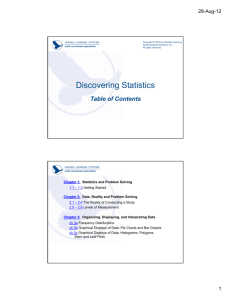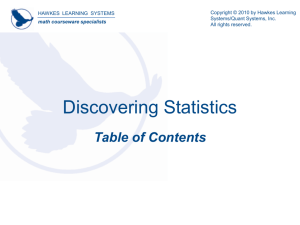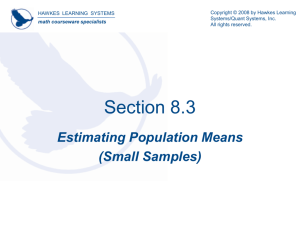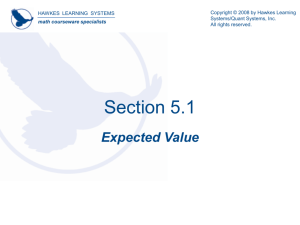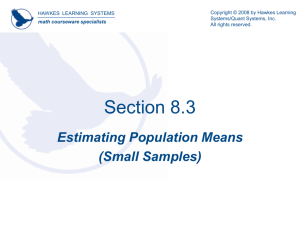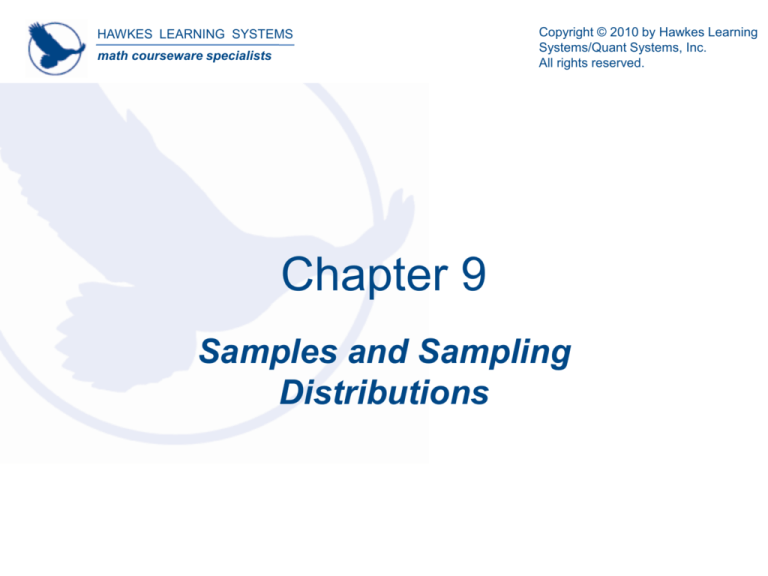
HAWKES LEARNING SYSTEMS
math courseware specialists
Copyright © 2010 by Hawkes Learning
Systems/Quant Systems, Inc.
All rights reserved.
Chapter 9
Samples and Sampling
Distributions
HAWKES LEARNING SYSTEMS
Samples and Sampling Distributions
math courseware specialists
Section 9.6 The Distribution of the Sample Mean
Objectives:
• To describe attributes of sampling distributions.
• To understand the concept of sample means.
• To understand the theory behind the Central Limit Theorem.
HAWKES LEARNING SYSTEMS
Samples and Sampling Distributions
math courseware specialists
Section 9.6 The Distribution of the Sample Mean
Definition:
•
Sampling distribution for sample means – describes the
means of all possible samples of a particular sample size from a
specified population.
HAWKES LEARNING SYSTEMS
Samples and Sampling Distributions
math courseware specialists
Section 9.6 The Distribution of the Sample Mean
Example:
Determine the sampling distribution of all possible samples of size
two of the diameters of the valves of respirators.
Valve Measurements
Valve
Diameter
It is important to realize the data set to the
left constitutes a population with
A
0.124
0.1486, and
B
0.136
2 0.00073.
C
0.201
D
0.144
E
0.138
Both the population mean and variance are
considered population parameters.
HAWKES LEARNING SYSTEMS
Samples and Sampling Distributions
math courseware specialists
Section 9.6 The Distribution of the Sample Mean
Example:
Determine the sampling distribution of all possible samples of size
two of the diameters of the valves of respirators.
Solution:
Sample Valve Measurements
Sample
Number
First
Observation
Second
Observation
x
1 (A & B)
0.124
0.136
0.1300
2 (A & C)
0.124
0.201
0.1625
3 (A & D)
0.124
0.144
0.1340
4 (A & E)
0.124
0.138
0.1310
5 (B & C)
0.136
0.201
0.1685
6 (B & D)
0.136
0.144
0.1400
7 (B & E)
0.136
0.138
0.1370
8 (C & D)
0.201
0.144
0.1725
9 (C & E)
0.201
0.138
0.1695
10 (D & E)
0.144
0.138
0.1410
HAWKES LEARNING SYSTEMS
Samples and Sampling Distributions
math courseware specialists
Section 9.6 The Distribution of the Sample Mean
Attributes of Sample Means:
• Central value of the variable (mean).
• Variability of the variable (variance).
• Familiar pattern of the variable (distribution).
HAWKES LEARNING SYSTEMS
Samples and Sampling Distributions
math courseware specialists
Section 9.6 The Distribution of the Sample Mean
Definition:
•
Unbiased – If the average value of an estimator equals the
population parameter being estimated, the estimator is
unbiased.
HAWKES LEARNING SYSTEMS
Samples and Sampling Distributions
math courseware specialists
Section 9.6 The Distribution of the Sample Mean
Bias:
Estimators are unbiased if the values are dispersed around the
central value.
Unbiased
Biased
HAWKES LEARNING SYSTEMS
Samples and Sampling Distributions
math courseware specialists
Section 9.6 The Distribution of the Sample Mean
Examples of Unbiased Estimators:
•
•
•
x is an unbiased estimator of .
p is an unbiased estimator of p.
s 2 is an unbiased estimator of 2 .
HAWKES LEARNING SYSTEMS
Samples and Sampling Distributions
math courseware specialists
Section 9.6 The Distribution of the Sample Mean
Definition:
Variance of the sample mean – it can be shown that for a
population of infinite size the variance of x x2 equals
2
x
2
n
where 2 is the population variance and n is the sample size.
Example:
For a population whose variance is 0.00073, calculate the
variance of the sample means for samples of size n = 2.
Solution:
2
x
2
n
0.00073
0.000365
2
HAWKES LEARNING SYSTEMS
Samples and Sampling Distributions
math courseware specialists
Section 9.6 The Distribution of the Sample Mean
Definition:
Variance of the sample mean – it can be shown that for a
population of finite size the variance of x x2 equals
where
2
x
N n 2
N 1 n
N = size of the population, and
n = size of the sample.
Example:
For a population whose variance is 0.00073, calculate the
variance of the sample means for samples of size n = 2,
assuming there is a finite population of N = 5.
Solution:
2
x
N n 2 5 2 0.00073
0.0002738
2
N 1 n 5 1
HAWKES LEARNING SYSTEMS
Samples and Sampling Distributions
math courseware specialists
Section 9.6 The Distribution of the Sample Mean
Example:
For a population whose variance is 0.00073, calculate the
variance of the sample means for samples of size n = 3,
assuming there is a finite population of N = 5.
Solution:
Note:
For
2
x
N n 2 5 3 0.00073
0.0001217
N
1
n
5
1
3
2
n=2, x 0.0002738
2
n=3, x 0.0001217
So as n grows larger the sample variance grows smaller.
HAWKES LEARNING SYSTEMS
Samples and Sampling Distributions
math courseware specialists
Section 9.6 The Distribution of the Sample Mean
Choosing Sample Sizes:
Based on the graphs below of a population with mean 43,660
and standard deviation of 2500 which sample size of n = 25,
n = 100, or n = 200 is preferred?
Solution:
Because it has less
variability it seems that
the estimator when
n = 200 would be
preferred.
HAWKES LEARNING SYSTEMS
Samples and Sampling Distributions
math courseware specialists
Section 9.6 The Distribution of the Sample Mean
Characteristics of Sample Means:
• The mean of the sample means is the population mean. Another
way of expressing this concept is to say that the expected value of x
is equal to the population mean. Symbolically, this can be
expressed as
E x . unbiasedness
• If the sample size is increased, the variability of the sample mean
decreases. This implies that the quality of the estimator tends to
improve as the sample size increases.
HAWKES LEARNING SYSTEMS
Samples and Sampling Distributions
math courseware specialists
Section 9.6 The Distribution of the Sample Mean
Central Limit Theorem:
If a sufficiently large sample (i.e. n > 30) is drawn from a population
with mean, , and variance, 2, the distribution of the sample mean
will have the following characteristics:
• An approximately normal distribution regardless of the
distribution of the underlying population.
• x E x (The mean of the sample means equals the
population mean.)
•
2
x
2
n
(The variance of the sample means equals the
variance of the population divided by the sample size.)
HAWKES LEARNING SYSTEMS
Samples and Sampling Distributions
math courseware specialists
Section 9.6 The Distribution of the Sample Mean
Central Limit Theorem:
Distribution of
the population
Distribution of the sample
mean for large samples
HAWKES LEARNING SYSTEMS
Samples and Sampling Distributions
math courseware specialists
Section 9.6 The Distribution of the Sample Mean
Central Limit Theorem:
Distribution of
the population
Distribution of the sample
mean for large samples
HAWKES LEARNING SYSTEMS
Samples and Sampling Distributions
math courseware specialists
Section 9.6 The Distribution of the Sample Mean
Central Limit Theorem:
Distribution of
the population
Distribution of the sample
mean for large samples
HAWKES LEARNING SYSTEMS
Samples and Sampling Distributions
math courseware specialists
Section 9.6 The Distribution of the Sample Mean
Central Limit Theorem:
Distribution of
the population
Distribution of the sample
mean for large samples
HAWKES LEARNING SYSTEMS
Samples and Sampling Distributions
math courseware specialists
Section 9.7 Using the Central Limit Theorem
Objective:
• To apply Central Limit Theorem to normal random variables.
HAWKES LEARNING SYSTEMS
Samples and Sampling Distributions
math courseware specialists
Section 9.7 Using the Central Limit Theorem
Example:
If a population has a mean of 30, a variance of 25, and a sample
of 100 is drawn from the population, what is the probability that the
sample mean will be larger than 31?
Solution:
2 25
n 100
30
Using Central Limit Theorem. The distribution of x will be normal with
a mean equal to the population mean, 30, and a variance given by
2
x
2
n
25
0.25
100
x 0.25 0.5
HAWKES LEARNING SYSTEMS
Samples and Sampling Distributions
math courseware specialists
Section 9.7 Using the Central Limit Theorem
Example:
If a population has a mean of 30, a variance of 25, and a sample
of 100 is drawn from the population, what is the probability that
the sample mean will be larger than 31?
Solution:
31 30
P
z
P z 2 0.5 0.4772 .0228
P x 31
0 .5
HAWKES LEARNING SYSTEMS
Samples and Sampling Distributions
math courseware specialists
Section 9.7 Using the Central Limit Theorem
Example:
If a population has a mean of 30, a variance of 25, and a
sample of 100 is drawn from the population, what is the
probability that the sample mean will be in error by at most one
unit from the true mean?
Solution:
To satisfy the condition that an error of less than one unit has
been made, the condition
x 1
must be satisfied.
P 29 x 31
P x 1 P x
P 2 z 2
.4772 .4772 .9544
HAWKES LEARNING SYSTEMS
Samples and Sampling Distributions
math courseware specialists
Section 9.7 Using the Central Limit Theorem
Example:
If a population has a mean of 30, a variance of 25, and a
sample of 100 is drawn from the population, what is the
probability that the sample mean will be in error by at most
one unit from the true mean?
Solution:
Thus, if a sample size of 100 is drawn from the population given in the
problem, the probability that the sample mean will be within one unit of
the population mean is .9544.
HAWKES LEARNING SYSTEMS
Samples and Sampling Distributions
math courseware specialists
Section 9.8 The Distribution of the Sample Proportion
Objective:
• To apply the Central Limit Theorem to population proportions.
HAWKES LEARNING SYSTEMS
Samples and Sampling Distributions
math courseware specialists
Section 9.8 The Distribution of the Sample Proportion
Definition:
•
Population proportion (p) – the percentage of a population that
has a certain characteristic.
•
Sample proportion ( ) – the percentage of a sample that has a
certain characteristic.
•
Notation: p is pronounced “p-hat”.
•
p is defined by the formula p
x
,
n
where x is the number in the sample possessing the characteristic
of interest and n is the sample size.
HAWKES LEARNING SYSTEMS
Samples and Sampling Distributions
math courseware specialists
Section 9.8 The Distribution of the Sample Proportion
Attributes of Sample Proportions:
• Central value of the variable (expected value).
• Variability of the variable (variance).
• Familiar pattern of the variable (distribution).
HAWKES LEARNING SYSTEMS
Samples and Sampling Distributions
math courseware specialists
Section 9.8 The Distribution of the Sample Proportion
Sample Proportions:
• The expected value of the sample proportion, p , is the population
proportion, p. Symbolically this is expressed as
E p p.
• The variance of p is given by
p2
p 1 p
.
n
Since p is the estimator for p, the variance of the sample proportion
is estimated as
p 1 p
2
p
.
n
HAWKES LEARNING SYSTEMS
Samples and Sampling Distributions
math courseware specialists
Section 9.8 The Distribution of the Sample Proportion
Sampling Distribution:
• The sampling distribution of p approaches normality as n becomes
sufficiently large. The sample size is generally considered sufficiently
large if
np 5, and
n 1 p 5.
Sampling Distribution of p
HAWKES LEARNING SYSTEMS
Samples and Sampling Distributions
math courseware specialists
Section 9.8 The Distribution of the Sample Proportion
Sampling Distribution of the Sample Proportion
• If the population is infinite and the sample is sufficiently large, the
distribution of p has the following characteristics:
1. An approximately normal distribution.
2. p E p p (The mean of the population proportions equals
the population proportion.)
3.
2
p
p 1 p
n
p 1 p
n
.
HAWKES LEARNING SYSTEMS
Samples and Sampling Distributions
math courseware specialists
Section 9.8 The Distribution of the Sample Proportion
Sampling Distribution of the Sample Proportion
• If the population is finite and the sample is sufficiently large, the
distribution of p has the following characteristics:
1. An approximately normal distribution.
2. p E p p (The mean of the population proportions equals
the population proportion.)
N n p 1 p N n p 1 p
,
3.
N 1
n
N 1
n
where N is size of the population.
2
p
HAWKES LEARNING SYSTEMS
Samples and Sampling Distributions
math courseware specialists
Section 9.8 The Distribution of the Sample Proportion
Example:
Suppose a sample of 400 persons is used to perform a taste
test. If the true fraction in the population that prefers Pepsi is
really .5, what is the probability that less than .44 of the persons
in the sample will prefer Pepsi?
Solution:
Assume the distribution of p is normal with E p .5,
2
p
.5 1 .5
0.000625, and
400
p .025.
HAWKES LEARNING SYSTEMS
Samples and Sampling Distributions
math courseware specialists
Section 9.8 The Distribution of the Sample Proportion
Example:
Suppose a sample of 400 persons is used to perform a taste
test. If the true fraction in the population that prefers Pepsi is
really .5, what is the probability that less than .44 of the
persons in the sample will prefer Pepsi?
Solution:
.44 .5
P p .44
Pz
.
0
2
5
P z 2.4 .5 .4918 .0082
HAWKES LEARNING SYSTEMS
Samples and Sampling Distributions
math courseware specialists
Section 9.8 The Distribution of the Sample Proportion
Example:
Suppose a sample of 500 is used to estimate the fraction of
voters that favor a particular candidate. If the population
proportion that favors the candidate is really .4. what is the
probability that the error of estimation will be less than .05?
Solution:
Since the true value of the population proportion is .4, the value
of p must fall between .35 and .45 in order for the error to be less
than .05.
E p .4
2
p
.4 1 .4
500
p .0219
.00048
HAWKES LEARNING SYSTEMS
Samples and Sampling Distributions
math courseware specialists
Section 9.8 The Distribution of the Sample Proportion
Example:
Suppose a sample of 500 is used to estimate the fraction of
voters that favor a particular candidate. If the population
proportion that favors the candidate is really .4. what is the
probability that the error of estimation will be less than .05?
Solution:
To find the probability that p is within .05 of the true mean, we
must find
P p .05 p p .05 P .35 p .45
HAWKES LEARNING SYSTEMS
Samples and Sampling Distributions
math courseware specialists
Section 9.8 The Distribution of the Sample Proportion
Example:
Suppose a sample of 500 is used to estimate the fraction of
voters that favor a particular candidate. If the population
proportion that favors the candidate is really .4. what is the
probability that the error of estimation will be less than .05?
Solution:
Using the z-transformation,
.35 .40
.45 0.40
P
z
.0219
.02
1
9
P 2.283 z 2.283
.4887 .4887
.9774

